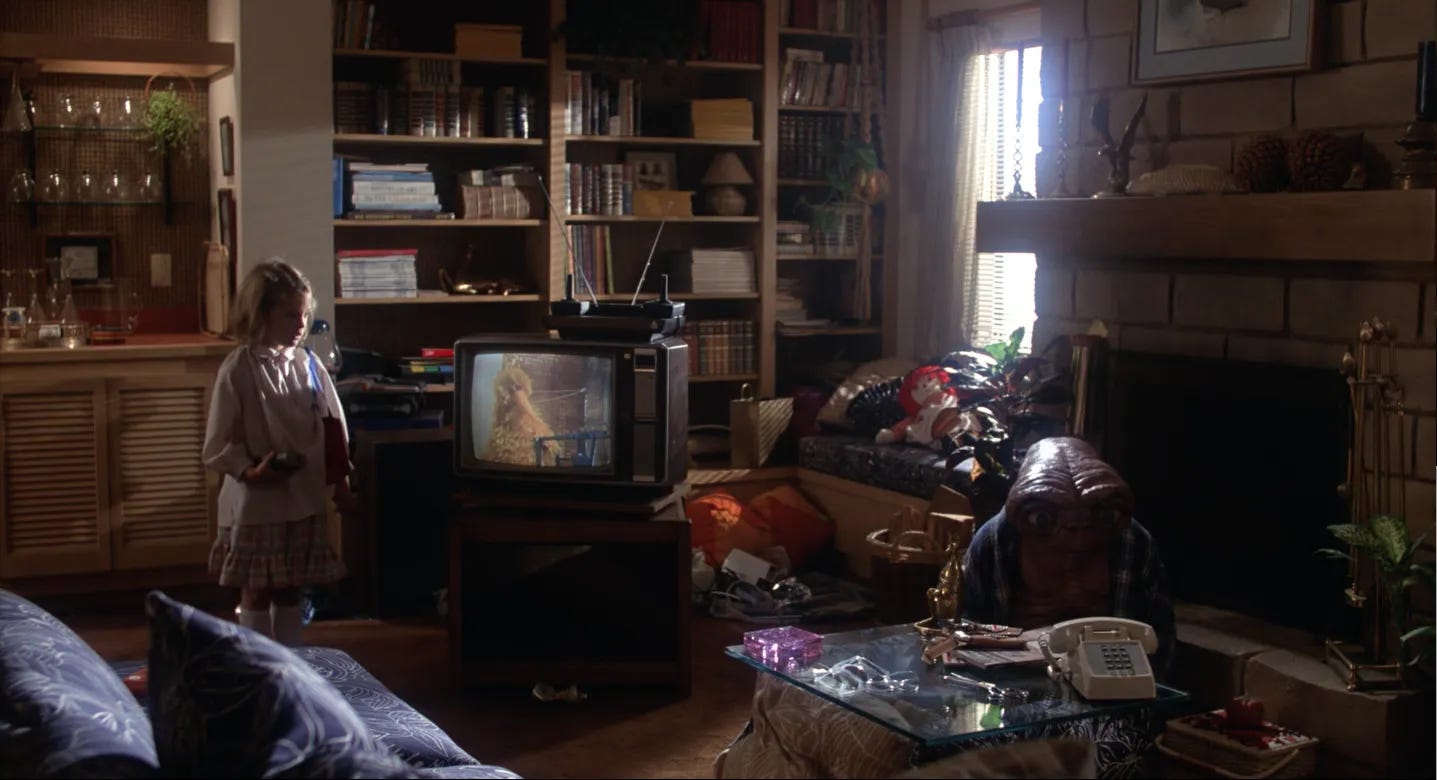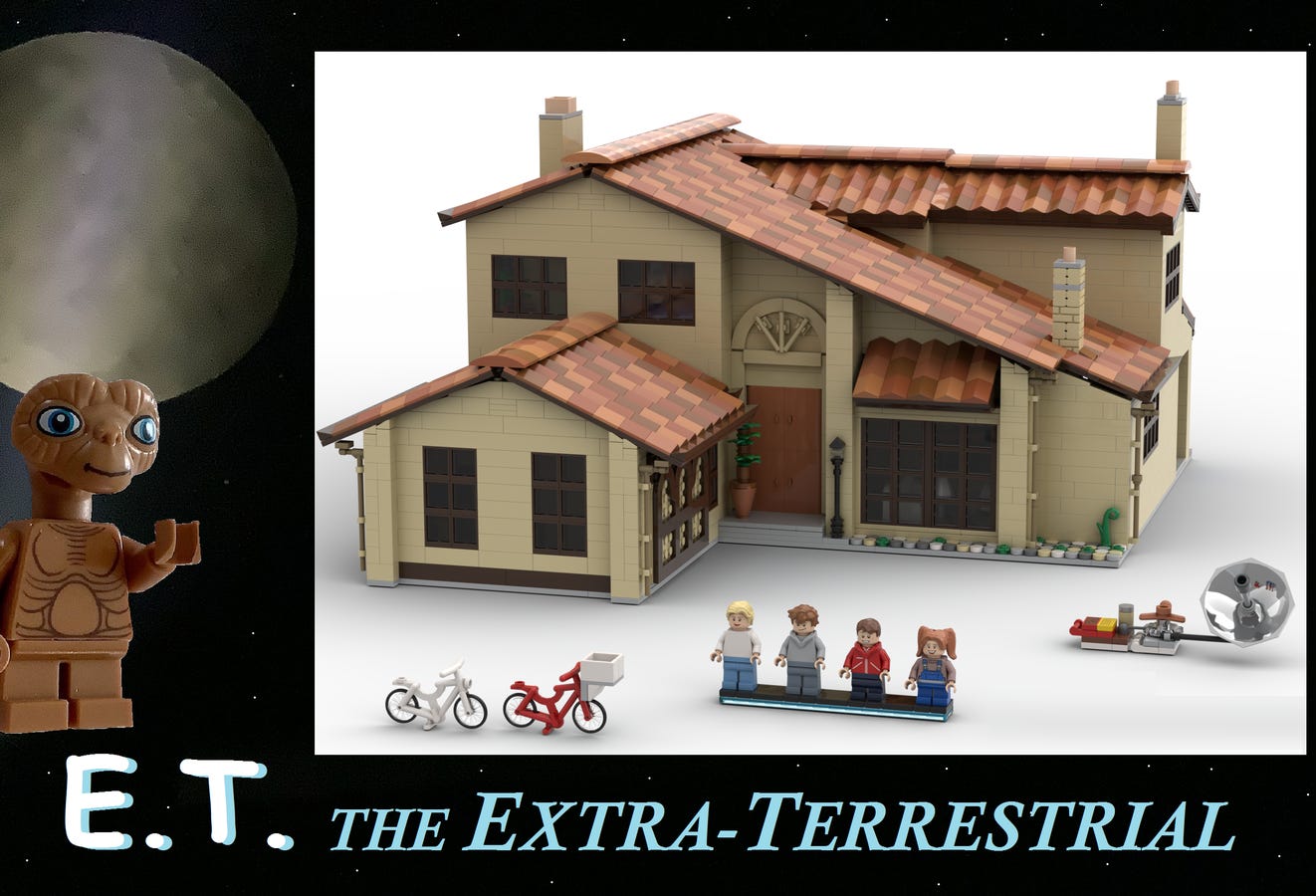There’s a lot of talk lately about how bad art is today (actually it’s usually just called “content” now—how bad content is). There’s lots of possible reasons for it—lack of good characters, lack of good atmosphere, style, etc. But for me, it comes down to a lack of imagination. I think when people lament the shittiness of art today, this is ultimately what they mean. And when art is good, it’s good because it is imaginative.
What does this mean? I think it’s better to start with what is not meant by imagination. It’s not about totally fabricating entirely new worlds that have no connection to our reality. It’s not about being far flung and different. People often think that’s what imagination is, but imagination is more about establishing a concrete sense of place that the audience can imagine themselves in, and then introducing one or two fantastical elements.
There are lots of examples you could give, but for me the best and simplest example is the movie E.T. (1982). It was the most successful Hollywood movie of all time for about ten years (until Jurassic Park surpassed it—also directed by Steven Spielberg).
E.T. is a very small story—it’s very domestic. Most of it takes place inside the main character Elliot’s house in Los Angeles. I always loved that house. It looks so comfortable and lived in.
There’s even a Lego set for E.T., and the main thing it includes is the house.
E.T. is the most popular, successful sci-fi/fantasy film of all time (other than maybe Star Wars), and it’s mostly just about this one normal house in the Los Angeles suburbs. (Avatar also should be noted, but I think that just proves my point, because that is about a place too—the planet Pandora, and those movies deal with that place more than anything else, like story or character, and audiences connect to that place because it is established very carefully and fully).
The most memorable scene, for me, was when E.T. has the house to himself while Elliot is at school, and he makes himself at home—he rummages around the refrigerator, finds some beer, tries the leftover potato salad and hates it and throws it on the ground…then has some more beer.
Just about the whole movie takes place in Elliot’s home. And of course, E.T. just wants to go home—he has to “phone home” first, and then goes home at the very end. The reason that E.T. (the movie and the character) resonated so incredibly well was because it was so grounded in a relatable domestic setting. We could all imagine ourselves living in that house, and it reminded us all of some part of our childhood (maybe this was more true back then when people could live in houses more easily, before the Great Recession turned everyone into a renter). And, crucially, it wasn’t a totally idealistic representation either—Elliot’s parents are separated. He mentions his Dad in an early scene, and his Mom has to stop herself from crying. And that bit of negativity makes it even more authentic and relatable—because home is our most comfortable place but it’s also where we experience our first sadness too. All of this is depicted so naturally and effortlessly in the early scenes of the movie. We are brought right into the world of the movie and we never question it—even though it’s a movie about a space alien.
When E.T. starts living in Elliot’s house, he fits in very well—he becomes part of the home. This creature from outer space fits seamlessly into this normal, relatable family environment. This is what is so satisfying about the movie—it does what imaginative art is supposed to do, it establishes a world that you feel at home in, and introduces something totally out of the ordinary, but in such a subtle, comfortable way, that you can really live with and feel this extraordinary element.
A movie like E.T. is so hugely satisfying, and so emotionally powerful, because it has such a solid sense of place, and introduces a sense of wild difference into it, so that you can really feel this magical difference. If it was all entirely made up, a totally different, distant world, then none of it would register—but bringing a space alien into such a well-formed domestic scene makes it register with unforgettable power.
And the role of the home is what makes the ending so terrifying. When the government quarantines Elliot’s home to do tests on E.T., they transform the home. I remember this part being really scary as a kid, because the comforting home environment was totally gone and made into this sterile, spooky thing.
This is true horror—having something that you feel so close to, suddenly becoming alien and strange. You imagined your way into this environment, and you became attached to it, and then suddenly it’s all smooth and featureless and you can’t stay there anymore. And this happens to all of us at some point—our home becomes alienated from us, as we move, or our parents move, and we have to find new places to call home.
Today we see movies that try to create entirely new worlds and settings but it’s all hollow and false. (And most of it is CGI too, just actors standing in front of a green screen). That isn’t real imagination. Real imagination is taking one modest thing and bringing the audience deeply into it, making them feel at home in it, then adding a fantastical element, so that it resonates in this comfortable zone you’ve created for them—and then changing it. E.T. does this so perfectly. There’s a reason it was the most successful movie of all time (until Jurassic Park came along).
Today big budget blockbusters try to do too much and fail to establish a sense of place, so they aren’t imaginative in a real way. And smaller movies don’t have any budget so they aren’t done with any style or skill. E.T. was a major movie that was focused on imagination in a specific, modest sense. That kind of thing doesn’t happen anymore.
It’s also harder to create a sense of place now, because it feels like we have much less in common today. But more than that, the focus is so much more about character, individuals, and “stories.” I’ve written about how the focus on story in film has ruined film before.
If you focus on place, then everything else flows from that. E.T. starts out by establishing the home as a place that you feel connected to, and then builds from there. Story, character, plot, everything else follows from that.
Imagination seeps out from an authentically realized sense of place—if you try to create outlandish, fantastical stories and characters, the audience won’t be able to imagine their way into it at all. Art today is more about relatability and representation—that the audience needs to be able to see themselves in the characters, they need to feel represented by the people they see. But if you put yourself directly into the art, then there’s no space for the imagination to work. You need to feel grounded in a sense of place, and then go from there. If you see your own particular sense of self represented—rather than a sense of place that you can feel—you are already limited, narrow, and too specific. That’s the death of imagination.









🔥 🔥 🔥
I thought the post would go in another direction, so I will just quote Nietzsche here:
"Concerning the psychology of the artist: For art to be possible at all—that is to say, in order that an æsthetic mode of action and of observation may exist, a certain preliminary physiological state is indispensable ecstasy. This state of ecstasy must first have intensified the susceptibility of the whole machine: otherwise, no art is possible. All kinds of ecstasy, however differently produced, have this power to create art, and above all the state dependent upon sexual excitement—this most venerable and primitive form of ecstasy. The same applies to that ecstasy which is the outcome of all great desires, all strong passions; the ecstasy of the feast, of the arena, of the act of bravery, of victory, of all extreme action; the ecstasy of cruelty; the ecstasy of destruction; the ecstasy following upon certain meteorological influences, as for instance that of spring-time, or upon the use of narcotics; and finally the ecstasy of will, that ecstasy which results from accumulated and surging will-power.—The essential feature of ecstasy is the feeling of increased strength and abundance. Actuated by this feeling a man gives of himself to things, he forces them to partake of his riches, he does violence to them—this proceeding is called idealising. Let us rid ourselves of a prejudice here: idealising does not consist, as is generally believed, in a suppression or an elimination of detail or of unessential features. A stupendous accentuation of the principal characteristics is by far the most decisive factor at work, and in consequence the minor characteristics vanish."